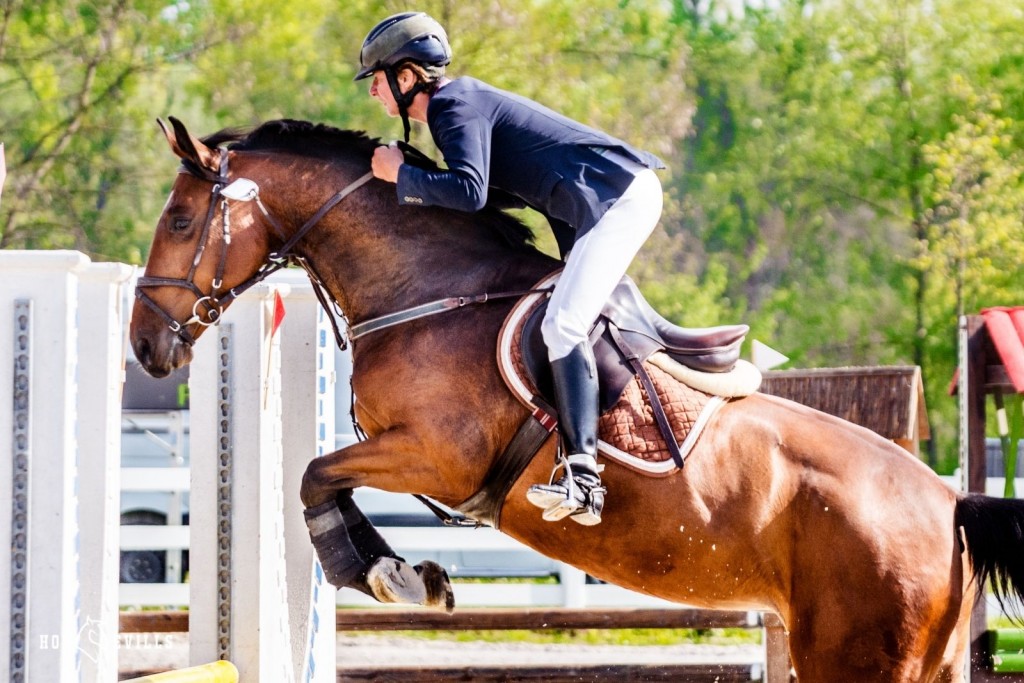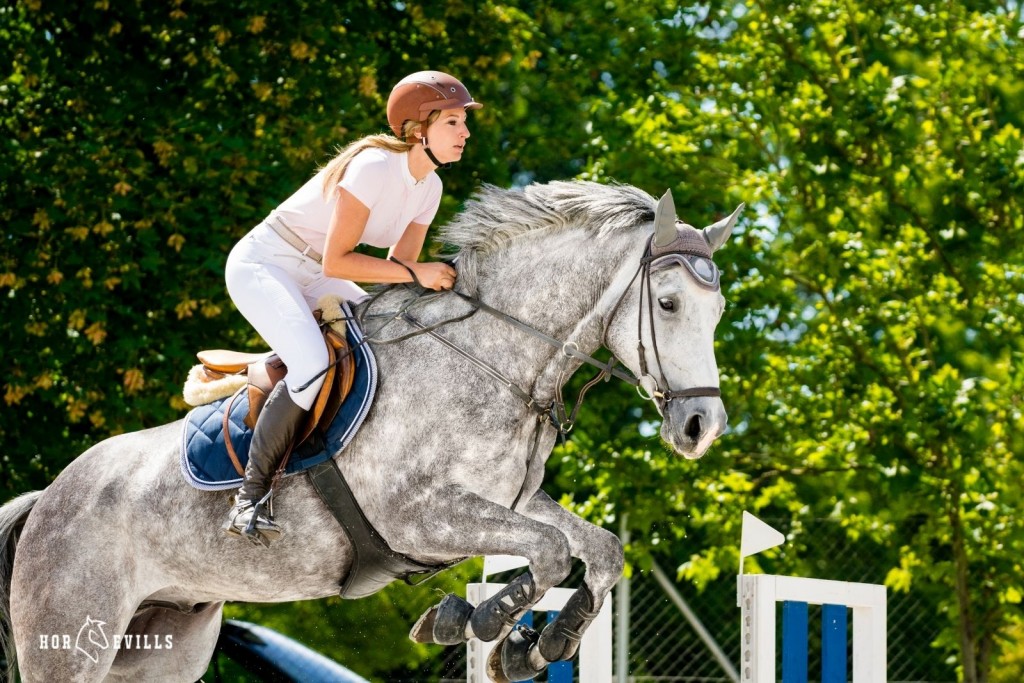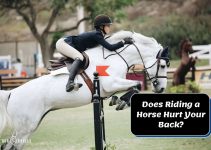One curiosity that equestrians always have is whether or not tack can be used from one discipline to another, such as the question “Can you use a dressage saddle pad for jumping?” “Do you need a saddle pad while horseback riding?” “Dressage saddle vs all purpose?”
Using tack in a multipurpose fashion can help save money and time.
In this article, I will explore if a dressage saddle pad can be used for jumping horses and the differences between these two types of saddles.
Let’s take a closure look.
Table of Contents
Can I Use a Dressage Saddle Pad for Jumping?
There is quite a difference in dressage vs jumping, from the rules of the sport to the tack. With this in mind, can you use a dressage saddle pad for jumping?
The consensus on this is that it is better to stick with the saddle pad for your discipline-specific saddle at shows and that it is not recommended when schooling at home but up to rider discretion.
Usually, saddle pads are designed to fit a specific type of saddle. For example, a jump saddle pad has the contour to match the curves of a jumping saddle. (1)

Additionally, jumping pads are shorter than the ones used in dressage Dressage saddle pads are longer and straighter in the front to accommodate the long flaps of a dressage saddle.
Dressage saddle pads are also bigger than jumping ones because dressage saddles are larger overall.
The FEI sets the international standard for what saddle pads can be used in each discipline in the show arena. You may get disqualified if you use the wrong equipment, so make sure you check the rules before you go competing.
However, while training at home, there are no restrictions on what tack you can use, so if your favorite dressage pad is in the wash, you can use whatever saddle pad you have on hand.
Just make sure it sufficiently fits your saddle, with the ends reaching outside your saddle edges
One time, I used a jumping pad when riding in a dressage saddle, and although I had no problems during my ride, the saddle did feel like it was slipping more than usual.
Make sure to check our review of the best ever saddle pads!
Check out this video about the important factors when choosing the right saddle pad size.
What is the Difference Between a Jumping and Dressage Saddle Pad?
Dressage saddle pads are long and straight while jumping saddle pads are short and have curved corners. This is because each pad is made to fit the shape of the saddle from its discipline.
Can You Use a Dressage Girth for Jumping?
Can you use a dressage girth for jumping? Although there is no rule against it, it is better to use saddle-specific girths when competing and to use your best judgment in other scenarios.

Like saddle pads, dressage vs jumping girths has unique qualities that are meant to be compatible with their respective saddles.
Dressage girths are much shorter than jumping girths because dressage saddles have long billet straps that the girth attaches to according to the experts at Kentucky Horswear. (2) They also have much longer leg flaps.
The length also prevents the girth from sticking out from under the saddle as you ride. Anatomical girths provide your horse with more freedom of movement.
Jumping saddles or all-purpose saddles have much longer girths because the saddle girth strap and leg flaps are shorter than that of a dressage saddle. A dressage girth is unlikely to be long enough to attach to jumping saddle billets.
The most popular girths for jumping are nylon girths and leather girths. The length of jumping girth means that neither you nor your horse will be bothered while going over jumps.
Just like with dressage vs jumping saddle pads, the FEI decides what girths can be used in each discipline while competing.
This video shows you the difference between dressage and jumping saddles and girths.
CHECK: Best Western Saddle Pads on the Market
Dressage vs Jumping Saddle: What’s Recommended for Jumping?
Based on the information in the above sections, it is clear that there are differences in the tack for dressage vs jumping disciplines.
Let’s look at how a dressage saddle vs jumping saddle compares to each other, and see what design features can influence the choice of saddle.
Dressage Saddle
Dressage saddles are built to be used for flatwork, which is the wider category of riding style that dressage falls into. Everything from the seat to the saddle flap ensures top performance.

Dressage riders are expected to maintain an upright posture and long leg at all times while riding in a seated position according to saddle experts. (3) The saddle helps the rider maintain these due to the deep seat and long flaps.
The deep saddle seat also helps the rider apply the right aids for both upper level and lower level movements while remaining upright and maintaining the correct position
The saddle cantle is higher than the saddle pommel allowing the rider to sit properly during the extended trot, which is used often in dressage tests.
Longer, straighter saddle flaps free up the horse’s shoulder, giving them the range of motion to perform the extended gaits that are prominent in the higher dressage levels.
Dressage saddle construction demands a simple and functional, yet elegant look that matches the graceful and poised aesthetic of the sport.
The long length of the girth straps, together with the shorter girth, give the rider the ability to have close contact with the horse’s body through their legs and seat.
The panels of the saddle typically do not have thick cushioning underneath them for this reason as well.
As a para-dressage rider, I ride in dressage saddles all the time, and they are very comfortable and definitely my saddle of choice.
Jumping Saddle
Jumping saddles are made to support the forward, 2-point position that is required to go over jumps and look forward to the next jump safely. They are in many ways the exact opposite of dressage saddles.

EquiSearch Magazine states that jumping saddles have a flatter seat and the saddle flaps are at a 45-degree angle to allow the rider to shorten their stirrups to the desired length. (4)
Shorter stirrups allow a jumping rider to sit comfortably in and maintain a balanced position, moving with the horse over jumps.
Many jumper riders will always use a jumping saddle but adjust their stirrup length, shortening them a couple of holes when jumping to provide them with more stability.
The short cantle and flat seat together encourage the rider to sit forward and move fluidly as the horse canters and jumps. When jumping, you are on the saddle, rather than sitting in it. They also provide closer contact with the horse.
Jumping saddles can have thigh rolls or blocks to provide extra support for the rider, and either be in close contact or normal variety, The choice of the jumping saddle depends on rider preference.
The panels of the jumping saddle are usually cushioned to provide shock absorption and protect the horse’s back as the rider moves.
The shorter girth straps or billets and longer girth accommodate the overall shorter and more lifted saddle, preventing chafing that is uncomfortable for both horse and rider.
The short saddle flaps and shoulder cutouts free the horse’s shoulders and give them the ability to gallop at top speeds and make the fastest time in the ring.
Jumping saddles are designed in a more athletic, forward-thinking, yet still elegant way to suit the more rugged, fast-paced nature of the sport.
READ MORE: How to Use a Gel Pad Under Saddle
Which Saddle is Recommended for Jumping?
Based on the discussion above, it is clear that a jumping saddle is the best choice for jumping. They are made in a way that allows the horse and rider team to be completely comfortable in an intense jumping round.

Can you jump in a dressage saddle? The short answer is sort of.
Although jumping in a dressage saddle is possible, they do not provide the right support to be able to follow the horse over a jump. (5) It is like trying to trudge through heavy snow in sneakers.
In a dressage saddle, you cannot stay in the two-point position that is necessary to jump accurately and safely. A dressage saddle also prevents you from getting out of the saddle, which you need to do over a jump.
Many riders report not feeling secure while jumping in a dressage saddle.
Here is a video of a rider attempting to jump in a dressage saddle.
FAQs
Is it wrong to jump your horse in a dressage saddle?
Jumping in a dressage saddle is not wrong, but it is not recommended because dressage saddles do not provide enough support for jumping. It also is not designed to provide the horse with the freedom of movement it needs to jump.
Can you jump in an all-purpose saddle?

Yes, all-purpose saddles are meant to be a good option for use in every discipline, within reason. An all-purpose saddle is fine for lower-level jumping, but you will want a dedicated jumping saddle the more you progress.
Why do dressage saddles have knee blocks or knee rolls?
Knee blocks or knee rolls help to keep the rider from falling too far forward and help them maintain the upright posture needed for dressage. They also help keep the rider’s leg in the correct position.
Can you use a dressage saddle pad with a GP saddle?
Using a dressage pad with a general-purpose saddle or all-purpose saddle is not recommended because all-purpose saddles have a contoured shape while dressage saddle pads are flat. This means that the pad is likely to now fully cover the areas the saddle sits on and can cause sore spots.
Conclusion
Can you use a dressage saddle pad for jumping? You can, but it is better if you find a jumping saddle pad because it matches the shape of a jumping saddle.
Each discipline has a specific tack to meet the demands they place on horse and rider.

Have you tried jumping using a dressage saddle pad? Let us know your experiences down below.
References
- “What Kind of a Saddle Pad Can I Have at Horse Shows?” Ophena, ophena.com/blogs/blog/what-kind-of-a-saddle-pad-can-i-have-at-horse-shows. Accessed 3 Apr. 2022.
- Kentucky. “The Basic of Girths | Kentucky Horsewear.” Www.kentucky-Horsewear.com, www.kentucky-horsewear.com/en/blog/the-basic-of-girths/#:~:text=If%20you%20want%20to%20offer. Accessed 3 Apr. 2022.
- “The Basics of Dressage Saddle.” Payless Saddlery, paylesssaddlery.com.au/blogs/news/the-basics-of-dressage-saddle. Accessed 3 Apr. 2022.
- Equisearch. “How Saddle Design Affects Your Riding Form.” Expert Advice on Horse Care and Horse Riding, www.equisearch.com/articles/saddledesign_032105.
- Schleese, Jochen. “Is It Wrong to Jump Your Horse in a Dressage Saddle?” Horsetalk.co.nz, 11 Oct. 2016, www.horsetalk.co.nz/2016/10/12/jump-horse-dressage-saddle/#:~:text=You%20simply%20will%20not%20have. Accessed 3 Apr. 2022.
- “Oh Dear..Jumping in a Dressage Saddle.” Www.youtube.com, youtu.be/dXPU1vn_eOE. Accessed 3 Apr. 2022.
Bryanna is a 23-year-old Florida-based Grade 1 Para-dressage rider based in Florida and she has been riding for 5 years. Horses are her passion and her ultimate goal is to be selected for the US Para-Equestrian Team and represent the US at the Paralympics. She rides at Quantum Leap Farm and Emerald M Therapeutic Riding Center and her equine partners are Shane, an American Paint Horse, and Cappy a Welsh x Thoroughbred. When she is not helping at the barn, riding, or training, she is learning about horses, writing articles about them, and using her social media platforms to raise awareness for therapeutic riding and para-equestrianism, shares her journey, and advocates for greater inclusion of para-equestrian in the media and equestrian sport at large.
Follow on INSTAGRAM and FACEBOOK
Read her Latest articles
Learn more about HER


![Top 9 Back Braces for Horseback Riding in 2024 [Expert Review]](https://horsevills.com/wp-content/uploads/2023/08/Back-Braces-for-Horseback-Riding-211x150.jpg)
